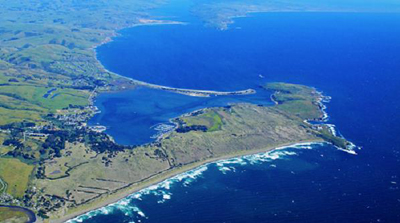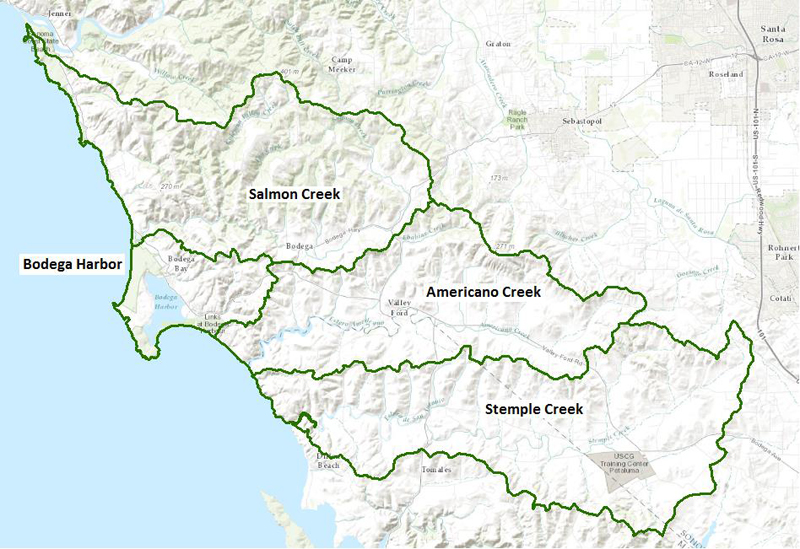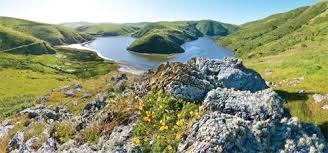Bodega Unit - HUC 115.00

Cool temperatures and relatively high rainfall due to coastal influences typify the Bodega Unit. The terrain in this unit is relatively steep, with the streams carving through the Coast Range and entering the Pacific Ocean south of the Russian River. Salmon Creek, Americano Creek, and Stemple Creek and their associated estuaries are the main waterbodies. These streams are located in erosive topography and are sensitive to land disturbance. Summertime flows are often non-existent in Americano Creek and Stemple Creek, while Salmon Creek flow is low but sustained. The estuaries of the Estero Americano (Americano Creek) and the Estero de San Antonio (Stemple Creek) are prized for their resemblance to fjords and the resource values associated with isolated estuarine areas. Both of these estuaries are designated Critical Coastal Areas along with the Bodega Marine Life Refuge.


Water Quality, Flow, and Water Rights
2012 Water Quality Assessment Report
Every six years the North Coast Water Board evaluates water quality information and identifies water bodies that do not meet water quality standards and are not supporting their beneficial uses. Those waters are placed on a list of impaired water bodies that identifies the pollutant or stressor causing impairment and establishes a schedule for developing a control plan to address the impairment.
Impaired Water Bodies in the Bodega Unit |
|||
Water Body |
Water Body Name |
Listing Extent |
Pollutant |
Bodega HU |
Bodega Harbor HA |
Entire water body |
Invasive Species |
Campbell Cove |
Entire water body |
Indicator Bacteria |
|
Estero Americano HA, Estuary |
Entire water body |
Nutrients |
|
Sedimentation/ Siltation |
|||
Estero Americano HA, Americano Creek |
Entire water body |
Nutrients |
|
Estero de San Antonio HA, Stemple Creek & Estero de San Antonio |
Entire water body |
Nutrients |
|
Sediment |
|||
Main program report page:
Map of water quality listed segments for Bodega Unit:
2008 North Coast Water Board’s Sediment TMDL Implementation Workplan
The Regional Water Board adopted a TMDL implementation policy statement in 2004 and a subsequent Workplan in 2008 that details efforts to address sediment impaired water bodies in the region. Specific to the Bodega Unit is the section on Stemple Creek and the Estero de San Antonio (page 202).
2003 Bacterial Source Identification Studies
A bacterial source identification study was conducted at the Campbell Cove beach by the Sonoma County Department of Health Services, under a grant from the State Water Resources Control Board, and with the assistance of the Bodega Marine Laboratory, the California Department of Parks and Recreation, and the North Coast Water Board. High bacterial levels historically resulted in seasonal beach closures at this popular Bodega Harbor beach. The study included vault pit privy dye testing, bacterial DNA analysis to identify contributing species of animals, harbor circulation studies, and animal use surveys of Campbell Cove. The results are presented in several small reports:
- Final contract report of findings and recommendations
- Bodega Harbor Circulation Study
- Campbell Cove Animal Use Assessment
- Summary Results of Water Sample E. coli DNA Ribotyping
1997 Stemple Creek TMDL
The North Coast Water Board adopted a Total Maximum Daily Load and Attainment Strategy for the Stemple Creek Watershed in 1997. It has not been finalized.
Facilities Regulated by the Regional Water Board
This link is an interactive map of permitted facilities in California. You can zoom in to the watershed of your choice and click on a facility to obtain information.
Sanitary Sewer Overflow Incident Map
This link is an interactive map of overflows from sanitary sewers. You can zoom in to the watershed of your choice and click on an incident to obtain information.
Water Rights Database
Statements of water diversion and use, registrations, certificates and water rights permits are accessible on the eWRIMS, Electronic Water Rights Information Management System. This link includes a mapping application.
California Environmental Data Exchange Network
Water quality and habitat data and information are contained at this site in a spreadsheet format. Pay careful attention to the instructions.
Landscape Information
2005 N. Coast Water Board Watershed Initiative Chapter, Russian/Bodega WMA
The North Coast Region developed a Watershed Initiative Chapter as part of the State Water Board's Watershed Management Initiative that provides an overview of that watershed, a description of its water quality concerns and issues, past significant Regional Board activities in the watershed, activities as of 2005, near-term activities that would benefit the watershed, and activities which may happen on a longer time-scale.
California Geographic Information Portal
This portal has a search engine for the portal itself and ArcGIS online. Information and GIS layers can be accessed for a variety of data, including hillshade, vegetation, rivers, contours, stream fish habitat by reach, stream inventory reports, and CalWater 2.2 maps.
CalFire Fire and Resource Assessment Program
This site contains a wealth of information on the amount and extent of forest and rangelands along with analysis of conditions. Maps, projects, and assessments are available on the site, including GIS layers for timber harvesting, vegetation, and other resources.
U.S. Natural Resources Conservation Service Geospatial Data Gateway
Environmental and natural resources GIS files are available at this site, along with an interactive national map viewer.
Watershed Condition Information
KRIS West Marin-Sonoma
This system was originally developed as a data repository and analysis and management tool for the Klamath River watershed. Information is available through this site for Salmon, Americano, and Stemple creeks, including maps, water quality data, fisheries data, photographs, and scientific references.
California EcoAtlas
This website provides access to information on wetlands, including integration of some water quality information.
Watershed Groups, Partnerships, and Collaboration
Salmonid Restoration Federation
This nonprofit group was formed in 1986 to assist salmonid restoration efforts in California by promoting "restoration, stewardship, and recovery of California native salmon, steelhead and trout populations through education, collaboration, and advocacy." Their web site contains a wealth of information on salmonids and habitat and stream restoration in California.
California Watershed Network
This nonprofit organization was formed in 2000 to help protect and restore watersheds in California through community-based networks. The website contains some information on watershed events and older information on watersheds of interest, but most of it has not been updated since 2011.
UC Davis Information Center for the Environment, Natural Resource Project Inventory
This database provides information on natural resource projects in California, including links to data and information collected by the projects.
Fisheries and Wildlife Information
UC Davis, Bodega Marine Laboratory
The University of California Marine Laboratory at Bodega Bay hosts an informative website full of information on the marine and terrestrial ecosystems in the area. Additionally, Bodega Marine Laboratory hosts a summertime seminar series at the lab, has many other educational opportunities, and provides information on research projects.
Bodega Marine Life Refuge
The State Water Resources Control Board has designated Areas of Special Biological Significance (ASBS) as those "ocean areas requiring protection of species of biological communities to the extent that alteration of natural water quality is undesirable." They are included under the Marine Managed Areas Improvement Act (The Marine Managed Areas Improvement Act (Chapter 7 (commencing with Section 36600) of Division 27 of the Public Resources Code.)
Main report with legal descriptions and maps
1979 Reconnaissance Survey Report
CalFish Cooperative Anadromous Fish and Habitat Data Program
This cooperative agency site provides information on anadromous fish habitat and populations in an interactive environment. The site has numerous links to information libraries and systems in California.
National Oceanic and Atmospheric Administration
NOAA Fisheries is responsible for listing and recovery efforts for anadromous fishes. The 2012 Recovery Plan for coho salmon in the North Central California Coast ESU contains information on the habitat, population status, stressors and threats, recovery efforts, and recovery strategy.
The links and information on this page are provided in an attempt to make a broad range of information available on a watershed basis. While the Water Board has been involved in work within watersheds with a variety of agencies and watershed groups, we cannot vouch for the currency or accuracy of information contained within the internet links we have included. We suggest that you check with the original sources if there is any question regarding currency, accuracy, or origin of information.
Created June 2, 2015
Web page contact: Robert Klamt, robert.klamt@waterboards.ca.gov(Page last updated 8/29/23)
Water is a precious resource in California, and maintaining its quality is of utmost importance to safeguard the health of the public and the environment.
Statewide Campaigns
EPA Water Sense
File an Environmental Complaint
Save Our Water
Flex Alert
Register to Vote


